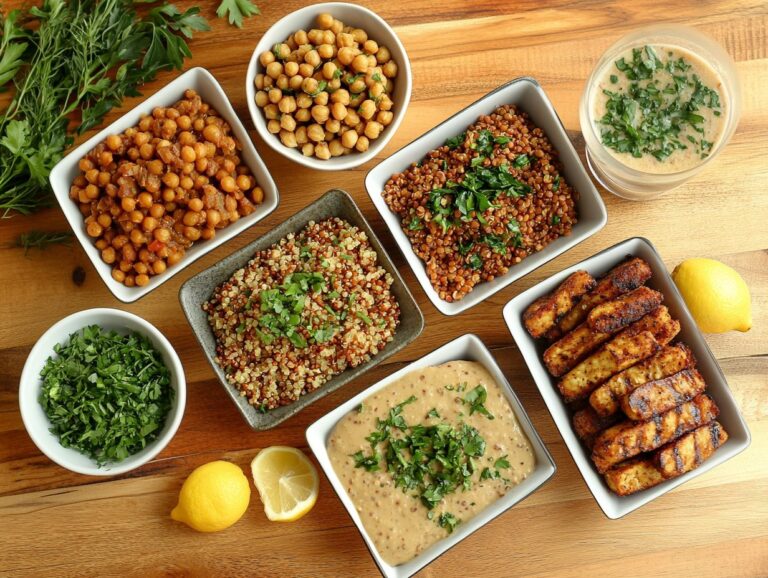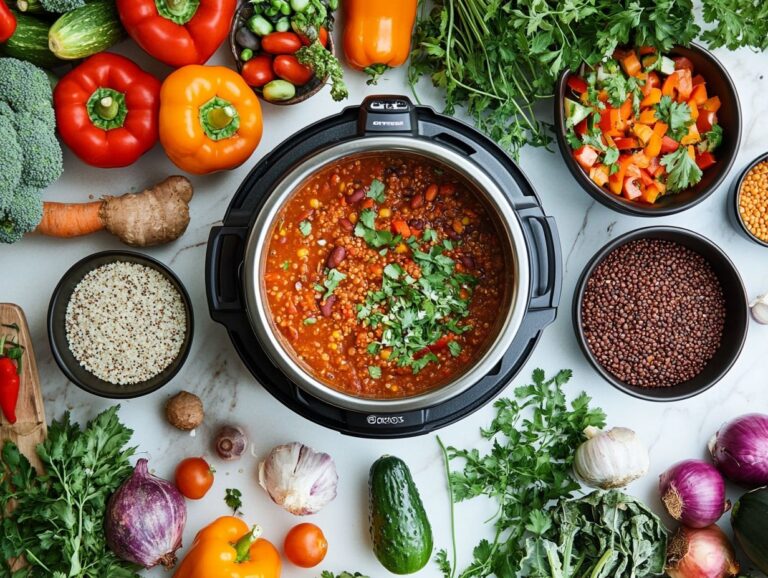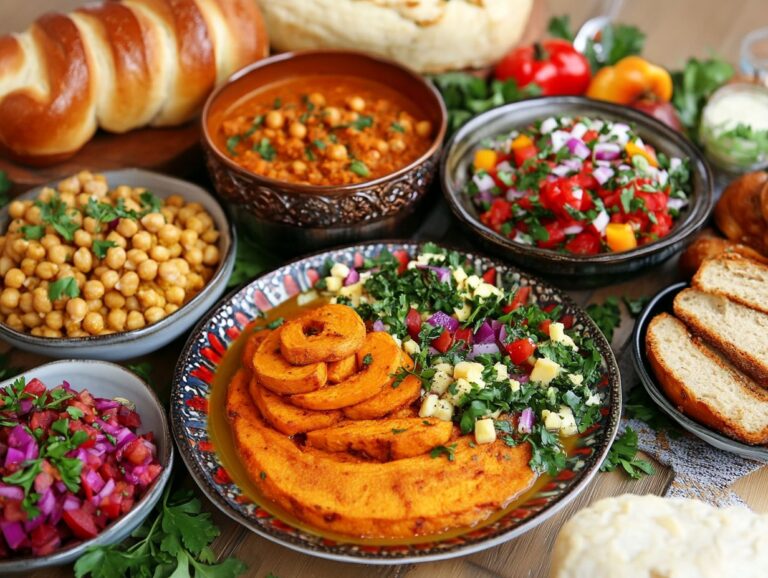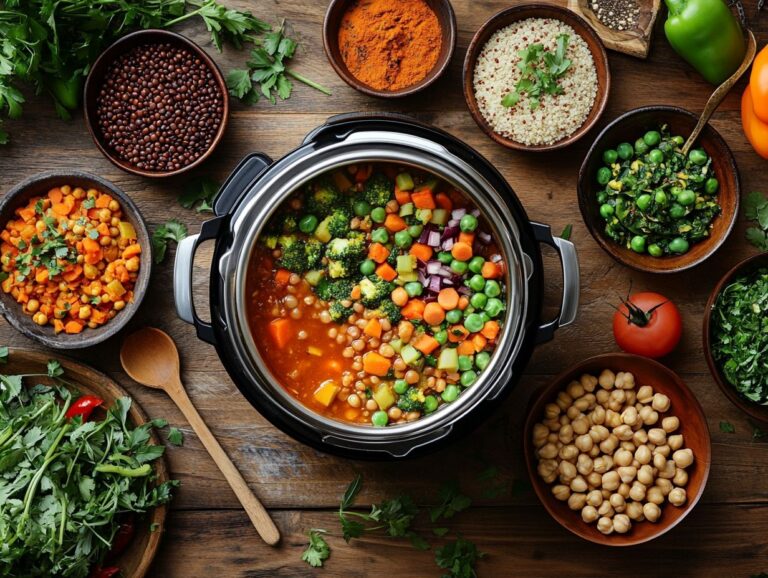Brazilian cuisine is celebrated for its vibrant flavors and rich traditions, and you can savor these culinary delights in a vegan-friendly manner. This article delves into the delectable realm of traditional Brazilian dishes reimagined for a plant-based diet. It highlights the health and environmental benefits of adopting a vegan lifestyle, along with key ingredients that enhance vegan cooking. You will find must-try recipes and tips for incorporating these exotic flavors into your meals. Whether you are a seasoned vegan or merely curious about plant-based eating, there is something here for everyone!
Overview of Traditional Brazilian Dishes
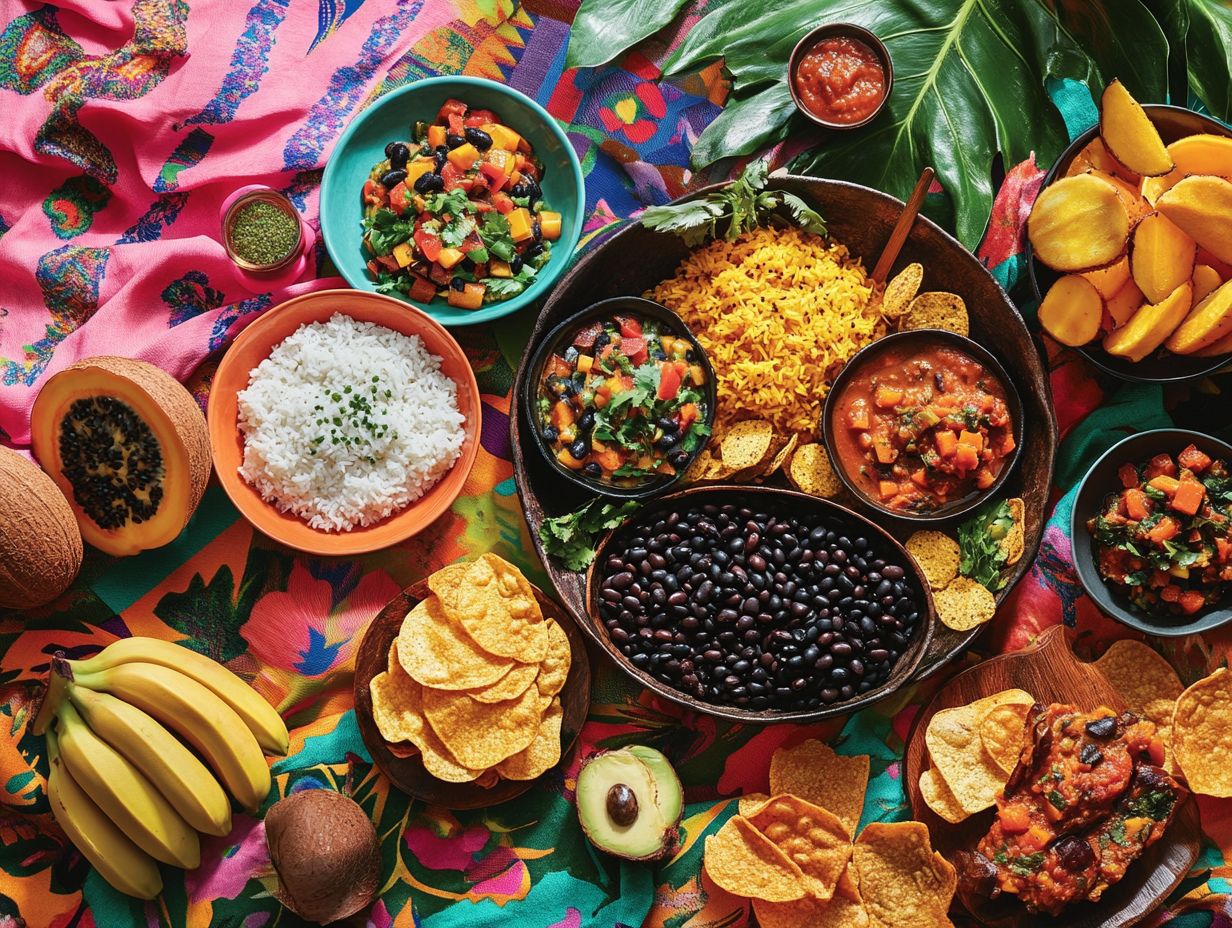
Brazilian cuisine is characterized by traditional meals that showcase the country’s diverse culture and history. Notable dishes include feijoada, Brazil’s national dish made from black beans, as well as açaí bowls, vatapá, moqueca, and acarajé, among others. These dishes often feature ingredients like cassava, dende oil, and tropical fruits, bringing vibrant flavors and textures to the table.
Savoring these traditional meals provides a unique opportunity to experience Brazil’s cultural heritage, as they are often prepared for celebratory gatherings and special occasions.
Benefits of a Vegan Diet
The advantages of veganism encompass both health benefits and positive environmental impacts. The vegan diet emphasizes whole, plant-based foods and sustainable practices, underscoring the importance of a nutritious diet that includes adequate amounts of vegan-friendly, nutrient-rich ingredients. Ingredients like quinoa, tempeh, and tofu offer excellent sources of plant protein, while palm oil and coconut add richness to vegan dishes.
Vegan meals are beneficial for both health and the environment, providing essential nutrients while fostering an awareness of a compassionate lifestyle among those who choose this diet. Adopting a vegan diet can lead to improved health, as it typically consists of a diverse array of fruits, vegetables, legumes, and grains. This not only promotes individual well-being but also encourages a deeper connection with the environment. Exploring international cuisine and traditional meals in a vegan context can make this dietary shift exciting and diverse.
Additionally, a vegan diet can spark creativity in the kitchen, allowing for the combination of various ingredients to create new and delicious meals. By experimenting with different cooking techniques such as roasting, grilling, and sautéing, home-cooked vegan meals can be both hearty and gourmet.
Health and Environmental Benefits
The health and environmental benefits of a vegan diet are numerous and interconnected, offering a dual advantage for both individuals and the planet. Veganism encourages the use of eco-friendly and sustainable practices, reducing the carbon footprint and promoting biodiversity.
Studies have shown that plant-based diets are associated with a lower risk of chronic diseases such as cardiovascular disease and diabetes, as well as improved weight management and overall health. Seasonal ingredients and wholesome meals play a significant role in achieving these health benefits.
Adopting a vegan lifestyle reduces the ecological footprint associated with animal agriculture, promoting a more sustainable food system that lessens greenhouse gas emissions, water usage, and land requirements by opting for nutrient-dense vegan ingredients. This shift also supports sustainable food pairings and culinary creativity.
Additionally, a vegan diet can lead to lower cholesterol levels, improved digestion due to increased fiber intake, and enhanced energy levels, allowing individuals to perform better in their daily activities. Engaging in community cooking and sharing recipes can further enrich the vegan experience.
This diet also benefits biodiversity by decreasing the demand for livestock farming, which is a major contributor to habitat destruction. Consequently, shifting to plant-based foods can help ensure a thriving ecosystem and maintain the balance of various species. Exploring different flavor profiles and food trends can make the plant-based journey more enjoyable.
Beyond the individual health advantages, these dietary choices foster a better relationship with nature.
Key Ingredients in Vegan Brazilian Cooking
The key ingredients in vegan Brazilian cooking highlight the vibrant and diverse nature of the country’s culinary traditions. This cuisine emphasizes the use of tropical fruits, legumes, and plant-based proteins that are essential for creating rich and flavorful meals. Ingredients such as chayote, jaca, and a variety of spices and sauces contribute to the authenticity and depth of Brazilian vegan dishes.
Staples such as black beans, quinoa, and cassava form the foundation of many traditional dishes, while fresh herbs and spices enhance the flavor profiles. Gluten-free options and creative food pairings are also integral to vegan Brazilian cooking.
Dishes like moqueca and feijoada can easily be adapted into vegan versions, showcasing the versatility of these essential ingredients. Furthermore, the abundance of fruits such as mango, papaya, and guava offers creative, sweet, and refreshing additions to any meal. These vibrant dishes are perfect for festive occasions and family meals.
Tropical Fruits and Vegetables
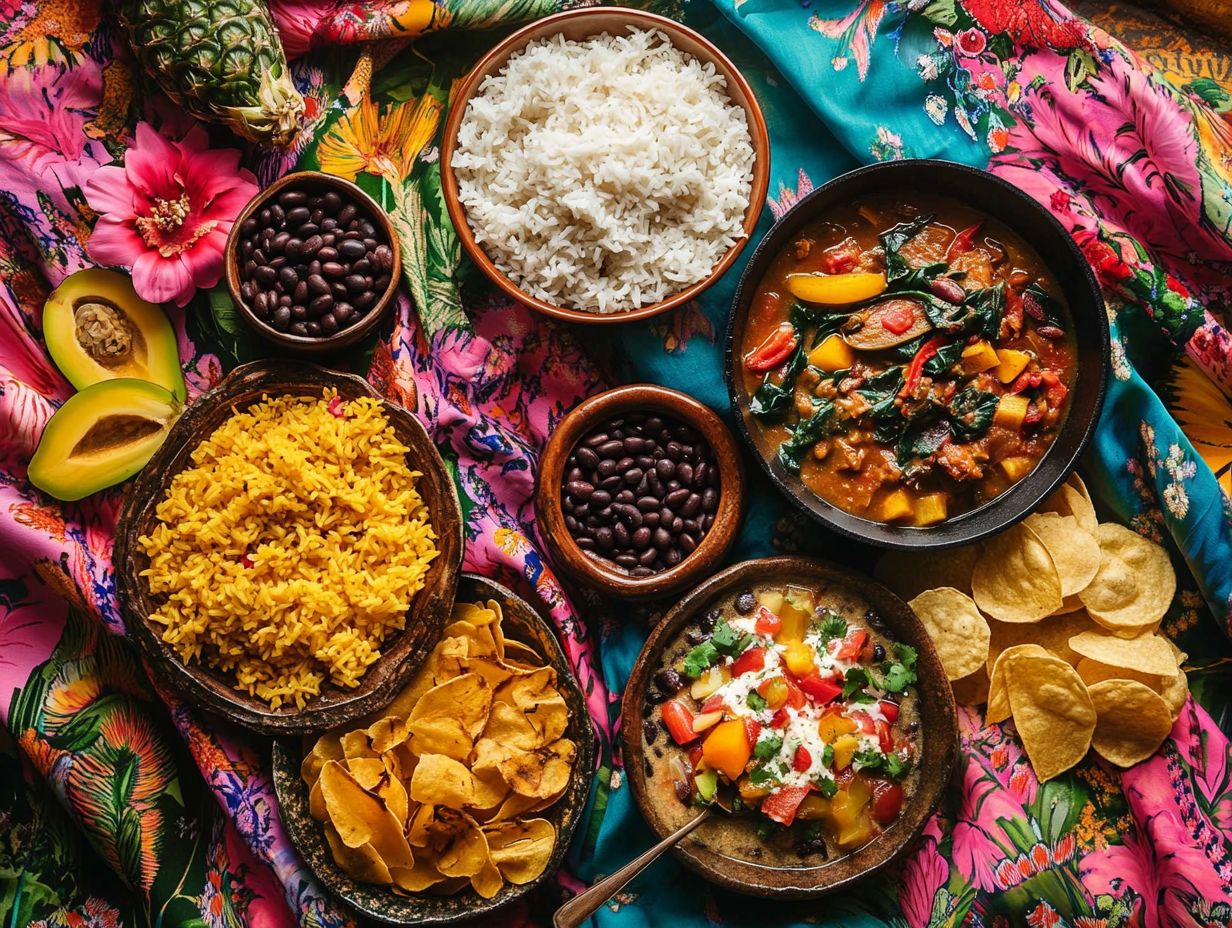
Tropical fruits and vegetables are essential components of vegan Brazilian cuisine. The vibrant fruits and vegetables of Brazil enrich dishes with appealing flavors, textures, and colors. Including these ingredients in salads, appetizers, and desserts can enhance the overall nutrition and taste experience.
Fruits like açaí, mango, and guava contribute natural sweetness while supplying important vitamins and minerals. Hearty staples such as cassava and sweet potatoes serve as the foundation for a variety of dishes. These ingredients are also ideal for quick recipes and meal prep, making it easy to enjoy nutritious and satisfying meals.
Incorporating these fresh, seasonal ingredients into meals offers a diverse array of exotic flavors that reflect the essence of Brazilian culture. These vibrant dishes can be beautifully presented with artistic plating, enhancing the food presentation and dining experience.
Plant-based Proteins
Plant-based protein sources are vital in vegan Brazilian cuisine, as they provide essential nutrients for a balanced diet while contributing to comforting and satisfying meals. Ingredients such as black beans, lentils, and quinoa are rich in protein and offer a diverse array of flavors that can be incorporated into many different dishes. These hearty proteins can be used in traditional recipes and modern vegan interpretations, highlighting the culinary exploration of Brazilian vegan cuisine.
These proteins can be included in stews, salads, and even traditional recipes like feijoada. By focusing on nutrient-dense plant-based proteins, one can create a wide variety of delicious and nutritious meal prep options. Embracing food trends and recipe variations can make vegan cooking an exciting journey.
Ingredients such as chickpeas and tempeh can further enhance the nutritional profile, offering additional protein along with fiber, vitamins, and minerals that are crucial for sustaining energy and improving digestive health. Incorporating these into savory dishes and street food recipes can provide a delightful culinary experience.
In Brazilian cuisine, these ingredients can be added to traditional dishes like farofa or used in modern recipes such as plant-based burgers, demonstrating the adaptability of these proteins. The inclusion of diverse plant protein options enriches the culinary landscape while supporting a nutrient-rich and environmentally friendly lifestyle. Exploring gourmet recipes and attending cooking classes can further enhance one’s culinary skills and creativity.
Must-Try Vegan Brazilian Recipes
Must-try vegan Brazilian recipes highlight the rich culinary diversity of Brazil and illustrate how traditional dishes can be adapted for a plant-based lifestyle without compromising on taste or authenticity. These recipes reflect the cultural diversity and vibrant colors of Brazilian cuisine, making them a feast for both the eyes and palate.
Dishes such as feijoada, a hearty black bean stew packed with vegetables, and moqueca, a coconut-based vegetable stew, provide excellent opportunities to explore bold flavors and nutrient-dense ingredients. These vegan street food adaptations bring a new dimension to traditional Brazilian dishes.
Vegan pão de queijo, a cheesy bread made without dairy, exemplifies the creative adaptations that can be made while still honoring Brazilian cuisine. These recipes not only delight the taste buds but also contribute to a healthy and sustainable diet. Engaging in recipe sharing and following food blogs can inspire more home-cooked vegan meals.
Feijoada (Black Bean Stew)
Feijoada is a traditional Brazilian dish typically made as a black bean stew with various meats. This vegan feijoada recipe offers a hearty and comforting meal while staying true to the original flavors. Ingredients such as black beans, mushrooms, and spices mimic the taste and satisfaction of the traditional recipe. It is commonly served with rice and garnished with fresh herbs. Vegan feijoada remains a beloved comfort food representative of Brazil’s culinary culture, providing all the same benefits without using animal products. This dish showcases the culinary creativity and taste sensations involved in vegan cooking.
Vegan Feijoada Recipe
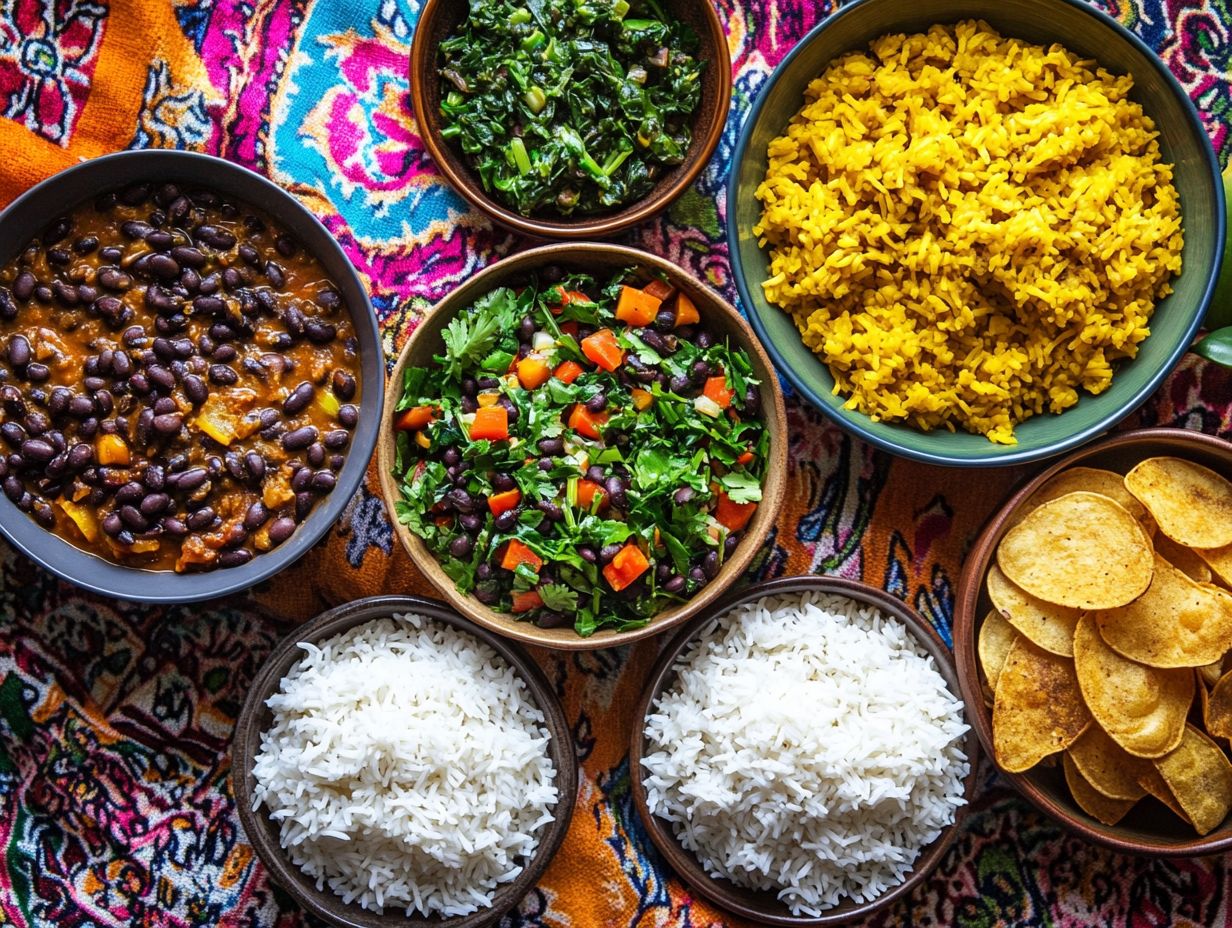
Ingredients:
- Black Beans: A key ingredient in feijoada, they are an excellent source of protein, fiber, vitamins, and minerals.
- Mushrooms: Portobello and shiitake mushrooms contribute a ‘meaty’ flavor and texture.
- Bell Peppers and Garlic: These provide a robust flavor base for the stew.
- Bay Leaves, Smoked Paprika, and Cumin: Essential seasonings that enhance the flavor of the feijoada.
- Olive Oil: A healthy fat used for sautéing at the beginning.
Steps to Make Vegan Feijoada
- Start by soaking black beans overnight to improve their texture and reduce cooking time.
- In a large pot, heat olive oil over medium heat and sauté chopped onions, bell peppers, and garlic to create a flavorful base.
- Add the soaked black beans, sliced mushrooms, and seasonings to the pot. Stir occasionally and let the mixture simmer for two hours. The aromatic spices will blend beautifully, creating a satisfying and wholesome stew.
- For serving, pair the vegan feijoada with white rice, slices of orange, and chopped fresh cilantro. This traditional meal can be beautifully presented with artistic plating, enhancing its appeal.
Vegan Feijoada Recipe Overview
- Prep Time: 15 minutes
- Cook Time: 2 hours 15 minutes
- Yield: 4 servings
Ingredients List:
- 1 cup dry black beans
- 6 cups vegetable broth
- 1 tablespoon olive oil
- 1 medium onion, diced
- 1 bell pepper, diced
- 4 cloves garlic, minced
- 8 ounces portobello mushrooms, sliced
- 4 ounces shiitake mushrooms, sliced
- 2 bay leaves
- 1 tablespoon smoked paprika
- 1 teaspoon cumin
- 1 orange, peeled and sliced
- Salt and pepper to taste
- Fresh cilantro, chopped
Instructions:
- Soak the black beans in a bowl of water overnight. Drain and rinse them. This step ensures the beans are tender and flavorful.
- In a large pot, heat olive oil over medium heat. Add the diced onion, bell pepper, and minced garlic. Cook for 5-7 minutes until softened.
- Stir in the black beans, vegetable broth, mushrooms, bay leaves, smoked paprika, cumin, salt, and pepper. Bring the mixture to a boil.
- Reduce the heat and let it simmer for about 2 hours or until the beans are tender.
- Remove the bay leaves before serving. Enjoy your vegan feijoada with white rice, orange slices, and fresh cilantro.
Moqueca (Coconut Fish Stew)
Moqueca is a traditional Brazilian stew characterized by its fragrant coconut milk base. While it is typically made with fish, a vegan version of moqueca can beautifully capture the dish’s tropical essence by incorporating plant-based ingredients. This vibrant stew can be prepared using a variety of vegetables, such as bell peppers, tomatoes, and zucchini, combined with coconut milk, palm oil, and herbs to create a rich, aromatic flavor profile.
Vegan moqueca can be served over rice or quinoa, providing a healthy and delicious way to enjoy this iconic Brazilian dish without animal products, all while retaining its authentic flavors.
To create a satisfying vegan moqueca, start by sautéing diced onions and garlic in a splash of olive oil until they become translucent and fragrant. Next, add colorful bell peppers and fresh tomatoes, along with spices like paprika and cumin, to enhance the dish’s depth. For a more exotic touch, consider including tropical fruits like chayote or jaca for added texture.
As the vegetables soften, stir in the creamy coconut milk and fresh cilantro to elevate the flavors to new heights. Incorporating dende oil can add an extra layer of authenticity. For an extra touch, a squeeze of lime juice just before serving will brighten the stew, making each bite a delightful experience that embodies the essence of the tropics.
Pão de Queijo (Cheese Bread)

Pão de queijo is a Brazilian cheese bread known for its chewy texture, often enjoyed as a snack or appetizer. A vegan version successfully replicates the texture and flavor without using dairy. This recipe utilizes tapioca flour and nutritional yeast to create a gluten-free cheese-style bread. These vegan pão de queijo bites can be served warm, making for a comforting treat that showcases both savory and sweet flavor profiles. Pão de queijo exemplifies the versatility of Brazilian cuisine.
Ingredients:
- 1 cup tapioca flour
- 1/4 cup nutritional yeast
- 1/2 cup mashed potato
- 1/2 cup water
- 1/2 tsp salt
- 1/4 tsp garlic powder
- 1/4 tsp onion powder
- 1 tbsp olive oil
Instructions:
- Preheat the oven to 375°F (190°C) and grease a mini muffin tin; set aside.
- In a saucepan, combine the water, olive oil, garlic powder, onion powder, and salt, and bring the mixture to a boil.
- Gradually add the tapioca flour, stirring until the mixture thickens and forms a dough. Remove from heat and let cool for a few minutes.
- Stir in the nutritional yeast and mashed potato, mixing until fully combined. Consider adding a dash of coconut milk for a richer texture. Allow the mixture to cool for several minutes, then incorporate the remaining tapioca flour.
- Using a mini ice cream scoop or spoon, fill the prepared muffin tin with the batter and smooth the tops.
- Bake for 20 to 25 minutes, or until golden brown and firm. Serve warm with a side of tropical fruit salad for a complete experience.
Notes: If you prefer not to use tapioca flour, you can substitute a gluten-free flour blend. Additionally, in a pinch, cashew cream (soaked cashews blended with water) can be used in place of nutritional yeast and mashed potato. The resulting texture will be different, but it should still be enjoyable. Experimenting with herbs and spices, such as thyme or rosemary, can also add an unexpected twist to the traditional flavor.
Tips for Incorporating Vegan Brazilian Cuisine into Your Diet
Vegan Brazilian cuisine is not only delicious and diverse but also easy to prepare and enjoy. Incorporating Brazilian food into a vegan diet is simple, thanks to easy substitutions and modifications that maintain the integrity of traditional recipes while making them healthy and plant-based. Exploring exotic flavors and vibrant colors can enhance your culinary journey.
By focusing on meal prep, you can simplify the process of enjoying Brazilian dishes as a vegan and ensure that fresh ingredients are always on hand. The rich culinary heritage of Brazil inspires creativity and fosters the establishment of a sustainable eating lifestyle when exploring its cuisine through a vegan lens.
Substitutions and Modifications
Substitutions and modifications play a crucial role in adapting traditional Brazilian recipes into vegan versions, ensuring that the flavors are preserved while accommodating plant-based diets.
For instance, vegan cheese can replace dairy products in recipes like pão de queijo, allowing the dish to maintain a similar texture and taste. Additionally, sauces and condiments can be adjusted to enhance the overall dish without straying from the essence of Brazilian traditional cuisine.
These substitutions not only promote healthy eating but also inspire creativity in the kitchen.
For example, coconut yogurt or cashew cream can be used instead of sour cream in recipes like feijoada, providing a creamy consistency with a hint of tanginess. Jackfruit serves as a popular substitute for chicken or pork in street food versions of coxinha or empadão.
Various legumes like beans can replace proteins, resulting in hearty and satisfying meals while preserving the vibrant flavors characteristic of Brazilian cooking. With careful ingredient selection and inventive combinations, home cooks can fully embrace the benefits of vegan Brazilian dishes.
How to Find Authentic Ingredients
Finding authentic ingredients for vegan Brazilian cuisine enhances the cooking experience and allows for a true representation of this vibrant culinary tradition. Using high-quality ingredients makes it possible to recreate beloved Brazilian recipes with both authenticity and flavor.
Local markets often provide fresh produce, such as cassava and tropical fruits, and may also offer unique spices and condiments that are not typically found in mainstream grocery stores.
Joining online communities or social media groups dedicated to Brazilian cooking can be helpful in discovering recommendations for reliable sources of less common ingredients. Additionally, seeking suggestions from local chefs or home cooks is encouraged; sharing knowledge within the community enriches everyone’s cooking experience and fosters a deeper connection to the roots of these delicious meals.
